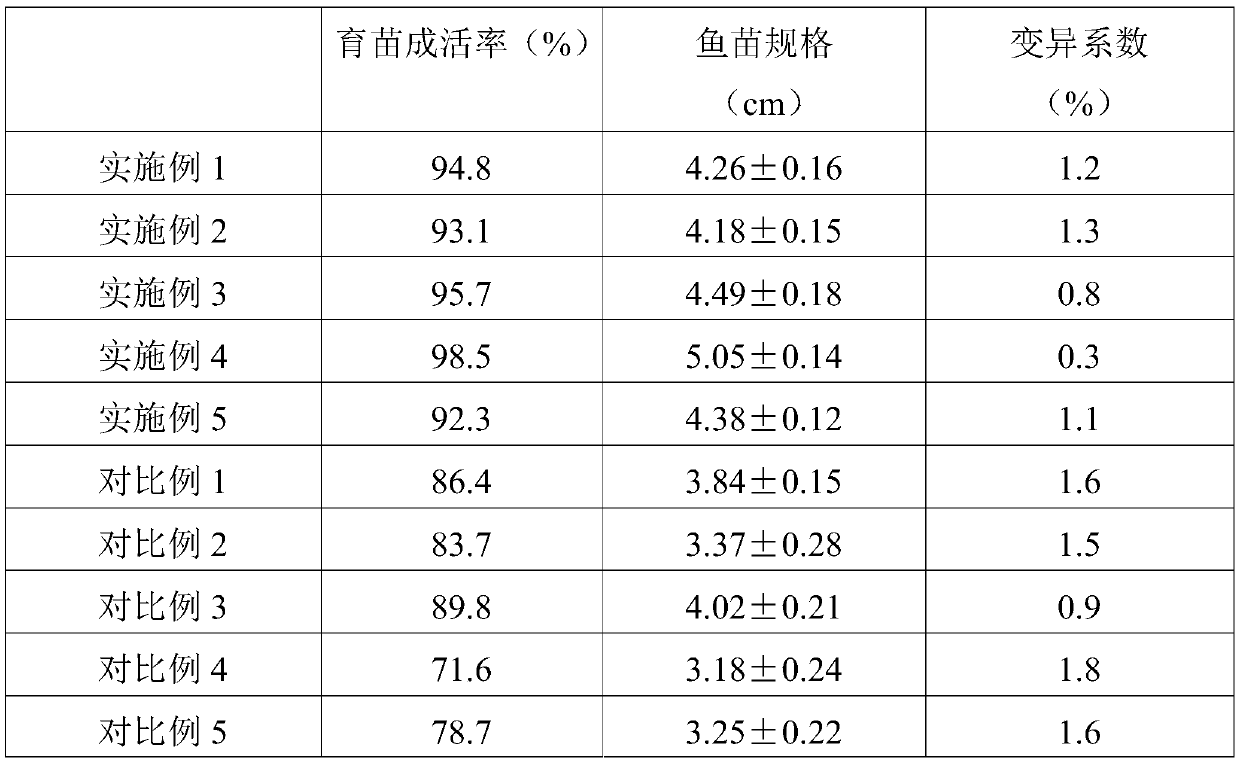Efficient outdoor ecological pond artificial fry breeding method for lutjanus argentimaculatus
An ecological pond and Zihong technology, which is applied in botany equipment and methods, food processing, climate change adaptation, etc., can solve the problems of unfavorable purple snapper expansion, insufficient size, and low survival rate, so as to improve the survival rate of fry And specifications, large specifications, high survival rate
- Summary
- Abstract
- Description
- Claims
- Application Information
AI Technical Summary
Problems solved by technology
Method used
Image
Examples
Embodiment 1
[0026] A method for artificially raising seedlings in an outdoor ecological pond of an efficient purple snapper, comprising the following steps:
[0027] (1) Choose an outdoor ecological pond of 1 mu, lay volcanic rocks, gravel, vermiculite and biological ceramsite at the bottom of the pond, the mass ratio is 1:1:4:0.8, and the laying amount per square meter is 1kg;
[0028] Before the larvae open their mouths, use pure natural light to cultivate Thalassiosira, Chlorella and Chrysophylla respectively;
[0029] (2) Before the larvae open their mouths, inoculate the pond with Thalassiosira 90,000 / mL, Chlorella 40,000 / mL, and Chrysophylla 10,000 / mL. After the water quality in the pond is stable, put the purple snapper larvae To the pond, the stocking density is about 30,000 tails / mu;
[0030] (3) In the larval stage after the larvae opened their mouths, oyster larvae were fed every day, and soy milk was sprinkled. The density of the oyster larvae was 5 / mL, and the soy milk was m...
Embodiment 2
[0034] A method for artificially raising seedlings in an outdoor ecological pond of an efficient purple snapper, comprising the following steps:
[0035] (1) Choose an outdoor ecological pond of 1 mu, lay volcanic rocks, gravel, vermiculite and biological ceramsite at the bottom of the pond, the mass ratio is 1:2:2:1.2, and the laying amount per square meter is 2kg;
[0036] Before the larvae open their mouths, use pure natural light to cultivate Thalassiosira, Chlorella and Chrysophylla respectively;
[0037] (2) Before the larvae open their mouths, inoculate the pond with 60,000 Thalassiosira sp., 60,000 Chlorella, and 30,000 Chrysophytes / mL. After the water quality in the pond is stable, put the purple snapper larvae into the pond. To the pond, the stocking density is about 30,000 tails / mu;
[0038] (3) In the larvae stage after the larvae have opened their mouths, feed oyster larvae every day, and sprinkle soy milk. The density of the oyster larvae is about 8 / mL, and the ...
Embodiment 3
[0042] A method for artificially raising seedlings in an outdoor ecological pond of an efficient purple snapper, comprising the following steps:
[0043] (1) Choose an outdoor ecological pond of 1 mu, lay volcanic rocks, gravel, vermiculite and biological ceramsite on the bottom of the pond, the mass ratio is 1:1.8:3:1, and the laying amount per square meter is 1.5kg;
[0044] Before the larvae open their mouths, use pure natural light to cultivate Thalassiosira, Chlorella and Chrysophylla respectively;
[0045] (2) Before the larvae open their mouths, inoculate the pond with 70,000 thalassira, 50,000 chlorella, and 20,000 golden algae / mL into the pond. After the water quality in the pond is stable, put the purple snapper larvae To the pond, the stocking density is 30,000 tails / mu;
[0046] (3) In the larval stage after the larvae opened their mouths, oyster larvae were fed every day, and soy milk was sprinkled. The density of the oyster larvae was about 7 / mL, and the soy mil...
PUM
 Login to View More
Login to View More Abstract
Description
Claims
Application Information
 Login to View More
Login to View More - R&D
- Intellectual Property
- Life Sciences
- Materials
- Tech Scout
- Unparalleled Data Quality
- Higher Quality Content
- 60% Fewer Hallucinations
Browse by: Latest US Patents, China's latest patents, Technical Efficacy Thesaurus, Application Domain, Technology Topic, Popular Technical Reports.
© 2025 PatSnap. All rights reserved.Legal|Privacy policy|Modern Slavery Act Transparency Statement|Sitemap|About US| Contact US: help@patsnap.com

